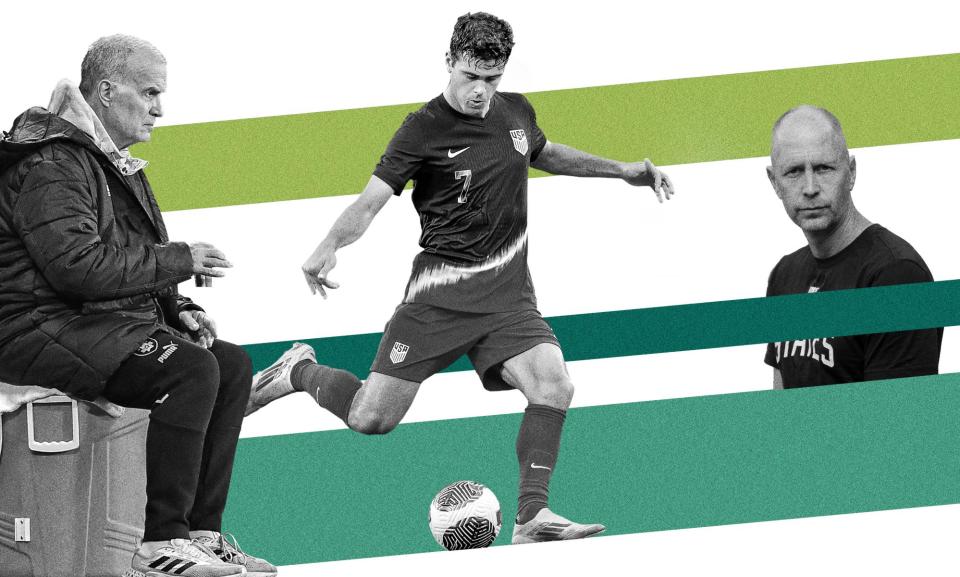Can the USMNT prove they are among the world’s best at Copa América?

The theory always was that what the USMNT needed was for more of their players to be playing with the best in Europe. Good, tough, regular competition, proper professional training, exposure to best practice at the highest level the game has ever known. That was what would transform the raw material the US produces into a genuinely top-level side that might be able to compete regularly with the world’s elite. Practice is never that straightforward.
The friendly against Colombia earlier this month was the first time the US had been able to field a starting XI all of whom play in the top flight of the Big Five European leagues (there’s a quibble over whether France can really be included in that grouping or whether Portugal or the Netherlands is more worthy, but let’s go with it for now as a useful shorthand to denote high European level). Was this then to be the breakout, the moment at which the US finally became a major world power in the men’s game?
There’s no sugar-coating that performance or that result, much improved as Colombia may be from the side that failed to qualify for the last World Cup. It was a mesmerisingly bad performance; it’s been a long time since the best teams have been dismantled by James Rodríguez or Juan Quintero, both of whom found a bewildering amount of space. But that doesn’t undermine the basic logic: the more players a country has operating at the highest level, the better it is likely to be. The problem – as countless South American and African sides have found over the years – is that players accustomed to the best may look at a domestic coach with a degree of disdain. Gregg Berhalter has been the USMNT head coach for seven years across two stints. The US have never been able to field more talent, but under Berhalter they have failed to notch a win over a Top 25 side in Fifa’s rankings outside Concacaf.
Before the Colombia debacle, things had been looking up for Berhalter. The spat with the Reyna family seems over, to the extent that Gio Reyna was named player of the tournament at the Concacaf Nations League, while victory in that tournament to some extent assuaged the disappointment of the semi-final elimination at the Concacaf Gold Cup last year. But the question now, with a home World Cup looming in two years, six years after the failure to qualify for a World Cup, is whether the US is any better equipped to compete with the world’s best than it was last time it staged a 16-team Copa América, in 2016.
Related: As Copa América approaches, the pressure is building on USMNT’s Gregg Berhalter
The format of this year’s Copa, which starts on Thursday, makes a lot of sense. If you were starting afresh, you’d almost certainly not have two separate confederations covering the Americas. Conmebol has struggled for a long time with finding a viable structure for a tournament to incorporate its 10 members; inviting six Concacaf sides to create a format with four groups of four is by far the neatest way of doing it. Formalising that for a regular tournament of the Americas, with proper qualifying, seems sadly improbable, but it has a lot of benefits, not least the TV markets of the US and Mexico.
The top Concacaf sides benefit too, exposing them to competition with a higher level of opposition than is possible in the Gold Cup. It’s one thing to have players spread across Europe – 15 of the 26 in Berhalter’s squad are at top-division sides in Europe’s Big Five leagues; the next stage is to have them playing together against leading nations. The concern about a 16-team Copa América is how few countries could successfully host them; the US may work financially but it’s not good for Conmebol if the tournament is regularly hosted outside its boundaries.
In 2016, the US beat Costa Rica and Paraguay to top their group despite losing to Colombia and overcame Ecuador in the last eight before a 4-0 defeat to Argentina in the semi-final. This time, the draw has been relatively kind. Panama are familiar opponents, while Bolivia have had a dreadful start to World Cup qualifying, losing five out of six, although their one win did come after a change of coach, Antônio Carlos Zago coming in for Gustavo Costas.
Uruguay are a different matter altogether. Marcelo Bielsa has worked his familiar magic, forming a new side around the spine of Ronald Araújo, Federico Valverde and Darwin Núñez, whose energy and determination in the press seem to matter more than his lack of precision in front of goal. They have beaten both Brazil and Argentina already in surging to second in World Cup qualifying.
It’s Argentina who are top, still inspired by Lionel Messi, and they remain the likeliest winners of this Copa América, with Brazil searching for direction after Dorival Júnior was belatedly appointed as coach. Colombia perhaps have an outside chance of winning a second title. In terms of tournament progression, that’s not great news for the US, with Brazil or Colombia likely to come in the quarter-finals. In terms of gauging standards before the World Cup, though, that represents a serious test.
This is an extract from Soccer with Jonathan Wilson, a weekly look from the Guardian US at the game in Europe and beyond. Subscribe for free here. Have a question for Jonathan? Email soccerwithjw@theguardian.com, and he’ll answer the best in a future edition

